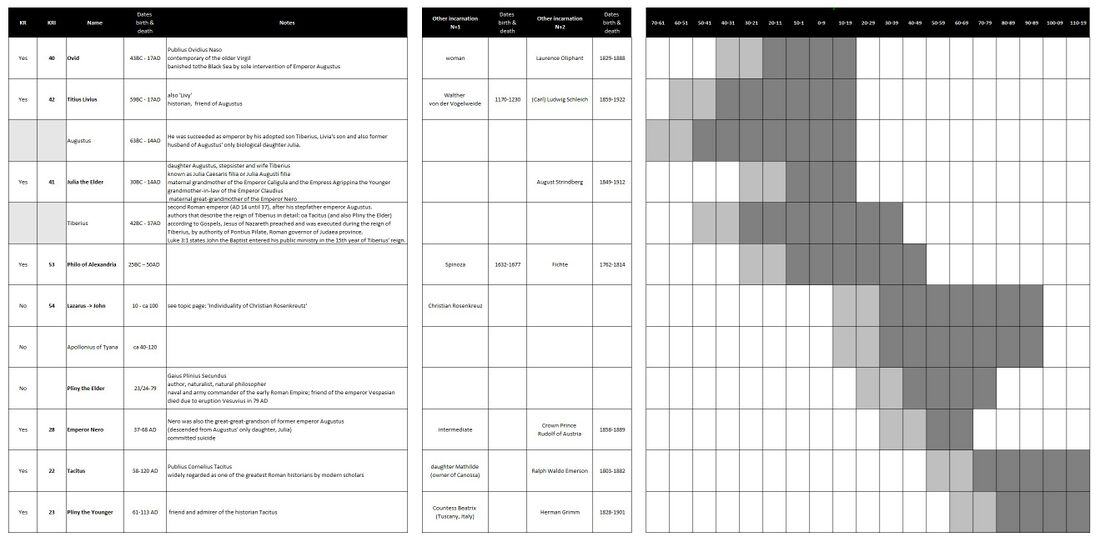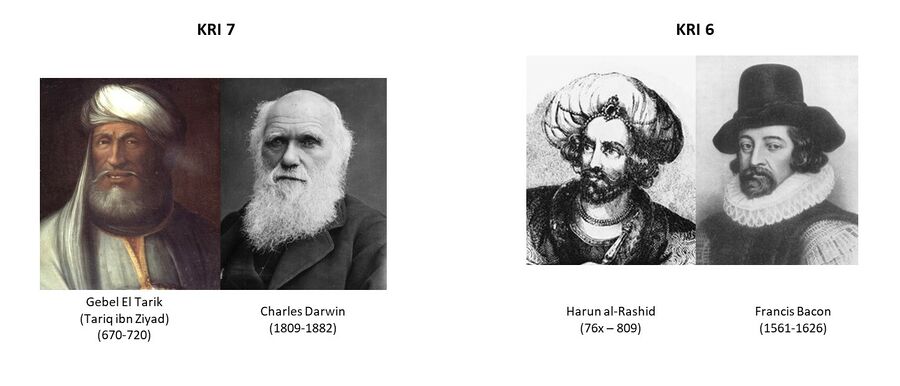Karma research case studies
Introduction
An in depth study of the life and work of Rudolf Steiner shows that his core mission was to bring humanity the renewed teachings of reincarnation and karma or destiny. For example see the book by Thomas Meyer: "Rudolf Steiner's Core Mission: The Birth and Development of Spiritual-Scientific Karma Research". From various studies (see a.o. Luigi Morelli) one can see how Steiner wanted to center his lectures and teaching on the theme of karma as of 1910, but the audience was just not receptive.
However, as of January 1924 however, Steiner started a series of Karmic Relationship lectures. In the next nine months until his death he would give over 80 lectures with karmic 'case studies'. And to the surprise of his audience, he now started using concrete case studies of known personalities which he named, described biographically, and for whom he also sketched previous incarnations and karmic background. Overall Rudolf Steiner described about 50 different instances of individualities with multiple incarnations, as case studies for karma research. More detailed information on KRI - Karmic Relationships Individualities
The reason and choice for these specific cases has deeper reasons that have surely not yet been grasped to the full extent. Steiner choose these particular Individualities for very good reasons, focusing on what he didactically wanted to convey about karmic research and patterns.
Note that study of Rudolf Steiner's Gesamtausgabe shows that quite a number of the personalities described in the 1924 KR were already covered before in lectures from 1905 onwards, and that Steiner was already touching on bringing the 1924 materials in the period 1910-1912.
Nomenclature
- with Individuality is meant the spirit who incarnates in multiple incarnations in various personalities. The Personality may differ greatly as a result of the transformation of soul characteristics. So we distinguish between an individuality (underlying) and its various personalities in the multiple incarnations. See Personality and Individuality.
- for karmic relationships and karmic groups, see topic page Karmic relationships
Biographical research
It is important to mention that Steiner gave specific descriptions as to how do biographical research in the context of karmic studies, and not only hinted at, but also asked some of his students to pursue specific cases. As a result, the individualities described have been subject of extensive study and a wealth of secondary literature exists on many of them.
As illustrations we can mention (see 'References and further reading' section below)
- systemic example is the work coordinated by Wolfgang Schuchhardt (various authors contributing to series of five booklets)
- Norbert Glas' biographical studies not just of the individualities covered, but also others eg Henry Stanley. Some of these studies were published posthumously by Meyer.
- The research done by Gunther Wachsmuth, Willy Sucher on the KR individualities on the basis of the birth & death charts of the incarnations
- As examples of various others, we refer to Albert Steffen, Hella Krause-Zimmer, Friedrich Hievel, Rudolf Treichler, Renate Riemeck, ..
Analysis
A wealth of qualitative study materials is now available on - in total - some 50 to 60 individualities. The question becomes: What are the implicit or hidden learnings in that material, how to extract, deduct these from the case studies, how to use them?
To our knowledge, besides the conclusions that can be drawn from biographical analysis, a first answer was given by Gunther Wachsmuth who compared the astrological birth and death charts of the personalities covered in the KR lectures, and discovered interesting patterns in the alignment of planets and zodiac signs between birth and death of incarnations of the same Individuality. It is possible, or likely, that Wachsmuth may have been acting on a tip by Rudolf Steiner, as we know that Steiner sometimes gave short informal clues to his closest students.
Aspects
- Individualities that have been initiates in former lives - in the world today
- On several occasion in the KR lectures, Rudolf Steiner asks the question 'where are the initiates of old', of previous cultural ages? (1923-03-23-GA235, 1924-04-05-GA239, 1924-05-25-GA239). One can imagine certain heavy-caliber Individualities to be impactful in the context of these 'impulses from waves of incarnating souls'. And Steiner gives examples with Garibaldi, Lessing, Comenius, Pestalozzi, Voltaire, Victor Hugo, Eliphas Levi. For illustrative examples, see the Schemas on topic page Karmic relationships.
- "men who were Initiates in an earlier life do not always give direct evidence of this in another incarnation. In spite of having been an Initiate in earlier Mysteries, it is only possible for a Man in any given age to absorb the spirituality and develop the constitution of soul which the body of that particular age allows." (1924-03-31-GA239)
- is it impossible anywhere in the civilized world with the standard system of education for the wisdom of older times to manifest directly in the form that you would expect, in a body that has received contemporary education upto age 17-18, having to learn to read and right at age 6-7. Highly evolved individuals can be recognised only by looking at manifestations of human nature not directly apparent but that reveal themselves, so to speak, behind him. (1923-03-23-GA235)
- see also: Hibernian Mysteries#initiates
- Adepts, masters or highly developed Individualities have great similarity of stature and form of the physical body from one incarnation to another .. "it is said that such a man is not born in a different body .. of a Master it is said: he is born in the same body" (1907-05-29-GA099)
- On several occasion in the KR lectures, Rudolf Steiner asks the question 'where are the initiates of old', of previous cultural ages? (1923-03-23-GA235, 1924-04-05-GA239, 1924-05-25-GA239). One can imagine certain heavy-caliber Individualities to be impactful in the context of these 'impulses from waves of incarnating souls'. And Steiner gives examples with Garibaldi, Lessing, Comenius, Pestalozzi, Voltaire, Victor Hugo, Eliphas Levi. For illustrative examples, see the Schemas on topic page Karmic relationships.
- Gunter Wachsmuth has found and illustrated certain patterns when comparing birth and death charts of related incarnations of the same Individuality, for example illustrations see Schema FMC00.502 and Schema FMC00.503 below. These two examples show unmistakenly patterns that cannot be called coincidental.
- it is apparent how the thread of Individuality which spans and connects various incarnations, has different 'types' of lives that vary greatly with regards to worldy societal impact. Some lives are working more innerly on karmic balances, others are more connected to the Impulses from waves of reincarnating souls that influence the river of historical and cultural development of mankind.
- examples:
- KRI 38: Plato - Hrotsvitha - Schröer: clearly Plato was a very impactful incarnation, Schröer much less as he's not even broadly known
- KRI 87: Origen - Spyridon - Daskalos: Origen was clearly a very impactful incarnation, some other incarnations that Daskalos described are not even known to history
- KRI 34: Goethe is described as being a follower of Plato in a previous life, seemingly not known to historical records
- KRI 44: Julian Apostate - Herzeleide - Tycho Brahe
- examples:
- advanced initiates or adepts may reincarnate each century, or with a few years or decades in between (as they no longer (need to) pass through the spirit world between death and a new birth). However historically some stand out, meaning many others are 'below the surface' of historical records or broad public impact. Examples: Individuality of Christian Rosenkreutz and Individuality of Master Jesus, Daskalos.
- additional cases not from Karmic Relationship lectures:
- the historical figures of Hektor (in Homer) and Empedocles re-appear after the MoG in the historical figures of Hamlet (by Shakespeare) and Faust (by Goethe) even though the poets were not conscious of this link (1912-09-15-GA139, see Greco-Latin cultural age#1912-09-15-GA139)
- Daskalos (KRI 87) and Sri M (see KRI88 KRI - Karmic Relationships Individualities#KRI 88: Sri M)
- Karma research case studies#Note 2 - Potential other correlation between Individualities mentioned by Rudolf Steiner in his lectures
Illustrations
Schema FMC00.241 as an example of a structured table, made on the basis of listening to KR lectures in chronological order.

Schema FMC00.672: shows categories of qualification of different sources of information for karma research case studies on Individualities related to Rudolf Steiner's work and life. This is important to qualify the source and related trustworthiness of information in context of studies of previous lives, as in some case conflicting hearsay memories cause conflicts or confusion.
Examples to illustrate: (1) Two conflicting candidates for incarnation Socrates (KRI 65); (2) Pythagoras as previous incarnation of Rudolf Steiner, a statement seemingly made by Beinsa Douno but also independently repudiated by Steiner in a conversation when Rittelmeyer asked him. (3) conflicting oral tradition and free interpretations regarding Jakob von Molay with both Felix Peipers and Elisabeth Vreede (Der Europäer Dec/Jan 2010/2011) (4) In short, many hearsay rumours and (in some cases, pure) hypotheses abound on important historical personalities and trigger speculative discussions, for example of possible links between Judas and Augustinus or Da Vinci, between Goethe and Moses, and so on.
Such speculations need to be carefully distinguished from clear and explicit statements by Rudolf Steiner in public lectures, and statements by other adepts: see overview of KRI Individualities with qualifier of this table in Schema FMC00.241B
See also related: Past life memories
Karmic Relationships Individualities (KRI)
Schema FMC00.241A: provides a reference to the Karmic Relationship Individualities (KRI) and the coverage by Rudolf Steiner in the lectures of the Karmic Relationship cycles, numbered chronologically - see Schema FMC00.265
See also the extended table Schema FMC00.241B
Karmic Relationship Lectures
Schema FMC00.265 provides the reference used for the Karmic Relationship Lectures with a unique KRL number ordered chronologically. Notice the KR cycles mix this logical chronological order. A few extra lectures from other cycles were added because they cover related subject matter.
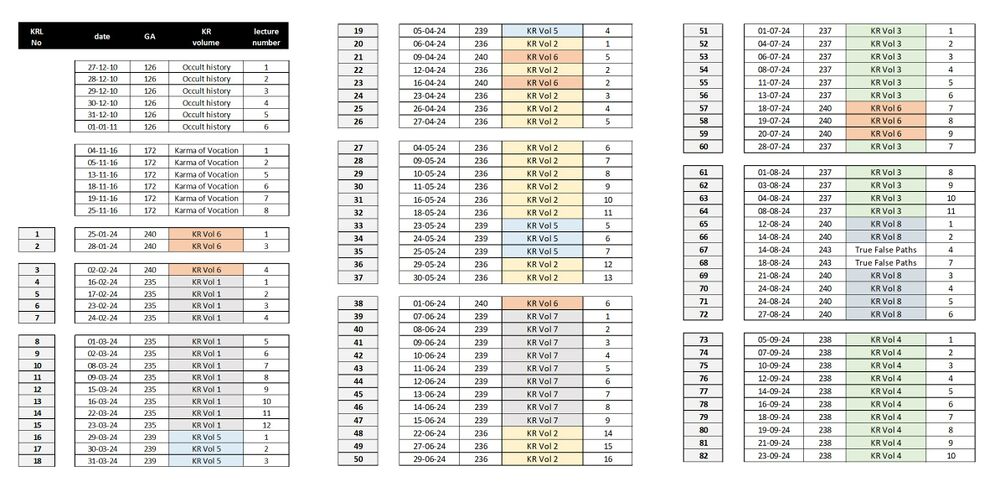
Various
Schema FMC00.531: depicts a simple metaphoric image for the main karmic patterns, challenges and debts in one's life or incarnation.
On the upper left is represented the accounting 'balance sheet' of karmic unbalances as a result of many previous lives, the 'book of lives' (part of Man's higher spiritual self or Individuality), also called 'causal body' in theosophy. In the accounting metaphor, each life delivers like the equivalent of 'annual results' that is added to the balance sheet in the process and journey between death and a new birth.
Quote: "don’t think that karma plays out in such a way that we would be able to immediately pay off all the debts we have incurred in a previous incarnation, in the next one. It is not that simple. Sometimes one will have to go through many, many incarnations.If you would be able to look back for a moment and see everything, all the marks in your astral body that need to be redeemed, prior to your rising to a certain degree of spiritual maturity, you would see your whole debt account." (1907-11-07-GA098)
The karmic ledger image also is used in this quote pointing out it is not always about the past but also about the future: "It is so easy to grasp everything that fits into the chain of our karma as a karmic debt ... [but] that is by no means always the case. As true as karma is a true, all-encompassing law, it is equally true that karmic events can be the very first to enter our causal context. The events that befall us are not always compensations for the past; often they are the first entries in our life's account, which will only find their corresponding balance in the future. Just as a merchant has to record entries for the first time on one side, so it is with the entries in our karmic ledger." (1905-07-23-GA264)
When we investigate our current life with biography work and karma exercises (on the right), we will find particularities, obvious or recurrent challenges, curious patterns. Some don't seem to belong in our experience of this current life, and/or may be an odd aspect of our Personality, even though we feel and have to acknowledge they are an intrinsic part of our true self (and Individuality). Depending on the individual, the process may include spontaneous Past life memories, whereby certain karmic patterns may clearly point to a particular previous incarnation. Importantly, the patterns are typically interwoven with relationships with key people in our lives (their role, impact, the period of our life) see Karmic relationships.
Rudolf Steiner gave examples of the above with the Karma research case studies about the KRI - Karmic Relationships Individualities.
During the journey between death and a new birth, before incarnating the soul develops a life plan in the spiritual world, and so each life has a selection of challenges to work and balance out these karmic unbalances - see a.o. Schema FMC00.287. The image of the slide projector depicts how patterns seen in one life stem from elements from various previous lives shown here as overlay slides.
Initiation is the process of fast tracking this process (versus the 'wheel of karma') by taking on this work on our human character consciously during incarnate life with daily initiation exercises.
Schema FMC00.243 shows an example of historical personalities covered by Rudolf Steiner. Click the image to enlarge.
KR numbers are the chronological lecture numbers as part of the Karmic Relationship lectures, as per FMC00.241 above. The schema illustrates 'human encounters' of important Individualities in a certain timeframe (peaking 1780-1800) and geography (Weimar, Jena).
More on this on the Karmic relationships topic page, oa See comments on the more extensive Schemas FMC00.243A and FMC00.497.
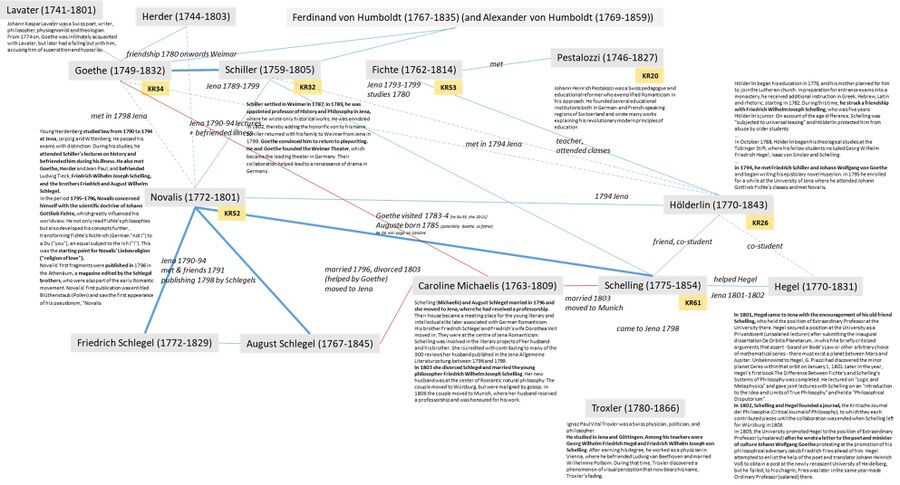
Schema FMC00.673: shows a number of Karmic Relationship Individualities (KRI) that had an incarnation in Rome in period of the century before and after Christ.
this includes Ovid, Titius Livius, Tacitus, Pliny the Younger, emperor Nero, all of them for which a 19th century incarnation is given along with other incarnations, and relationships between two Individualities such as Tacitus and Pliny the Younger.
Regarding Apollonius of Tyana, this high adept influenced four consecutive Roman emperors: he "played an important political part in the reign of Nero" and "gained considerable influence on Roman politics under Vespasian and Titus, so much so that it may be said that he was the soul of the Government under these two emperors." .. and was "actively connected with Nerva" (see 1918-08-25-GA183)
Illustrations KRI Individualities
Schema FMC00.502 shows (above) birth and death horoscopes for two personalities of the same individuality KRI=50. It is an example taken from Wachsmuth (1956, see 'Further reading' section below). The two charts below show the remarkable clustering of planets in certain zodiac signs for birth and death of the two incarnations (so four planetary positions 1 to 4). Wachsmuth identifies alignments, oppositions and squares.
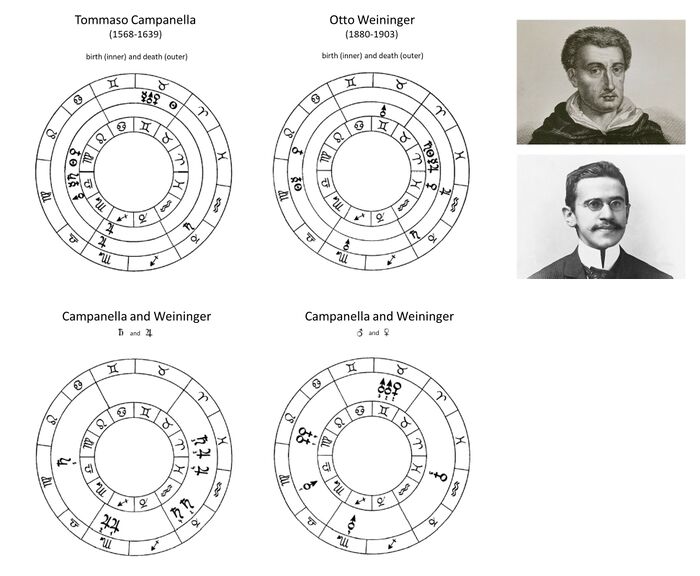
Schema FMC00.503 shows (left) birth and death horoscopes for two personalities of the same individuality KRI=52. It is an example taken from Wachsmuth (1956, see 'Further reading' section below). The four charts on the right show the remarkable clustering of planets in certain zodiac signs for birth and death of the two incarnations (so four planetary positions 1 to 4). Wachsmuth identifies alignments, oppositions and squares.
Observe the remarkable clustering of four planets cluster in three zodiac signs (Taurus-Aries-Pisces), whereas Jupiter and Saturn take positions in the other zodiac signs (also with certain patterns).
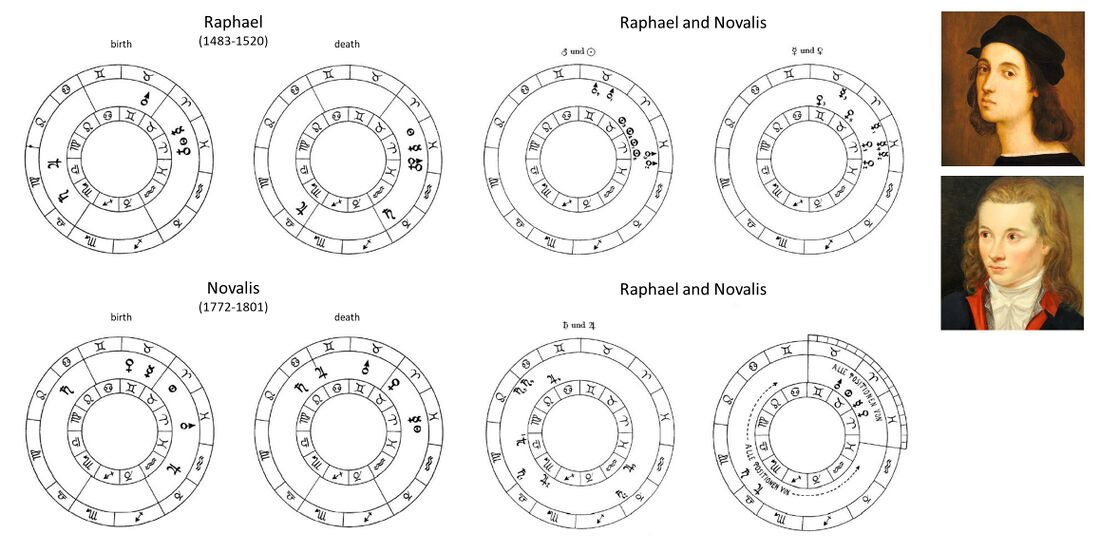
Schema FMC00.510: illustrates two Individualities described in Rudolf Steiner's Karmic Relationships lectures of 1924. The KRI stands for Karmic Relationship Individuality, the unique ID for each Individuality, as per overview Schema FMC00.241A.
The illustrations of these personalities were taken from the internet public domain. For ancient time periods, the representations may not always necessarily be trustworthy or documented, one can even argue they were made up (but then even more interesting the 'coincidence'), nevertheless and despite all reservations, the purely visual side-by-side may trigger a feeling of correspondence.
The series of this Schema FMC00.510 and its variants FMC00.510A etc are supporting illustrative material to the quote from 1907-05-29-GA099: "highly developed Individualities have great similarity of stature and form of the physical body from one incarnation to another .. "it is said that such a Man is not born in a different body". See also Schema FMC00.503 (Raphael-Novalis) and Schema FMC00.502 (Campanella-Weiniger).
Schema FMC00.510A - for explanation of this series see Schema FMC00.510.
Above: Rudolf Steiner talked on several occasions about Spinoza, Fichte and Philo of Alexandria being incarnations of the same Individuality. On the left are fairly trustworthy depictions (and compare the noses, for example); the illustrations on the right were added because it's still interesting how an imaginary depiction from the middle ages of Philo is shown 'coincidentally' with such expressive eyes, whereas the eyes are also a characteristic in Spinoza's and Fichte's facial expression.
Below: Rudolf Steiner lectured about Tolstoj but never publicly stated a link with Socrates. He did do so however in an informal conversation, for more info see KRI - Karmic Relationships Individualities#KRI 65: Tolstoj.

Lecture coverage and references
Coverage overview
Rudolf Steiner's early tentatives to bring the teachings of karma and reincarnation
It is not commonly known, or widespread knowledge, that already before the famous 1924 karmic relationship lectures, Rudolf Steiner made several early attempts to bring exactly that some knowledge. Below are listed some examples of the periods 1903-1904, and again the period 1910-11. (See o.a. Luigi Morelli who discusses this also).
He commented himself that the theosophical audience at that time was not ready or receptive. Also, it was only after the events of 1923 that Steiner was free to lecture to the full extend, as the counterforces had been silenced.
Reference extracts
1903-08-24-GA090C
mentions the cases of Cusanus/Kopernicus and Philo/Spinoza/Fichte (see Schema FMC00.510A)
1903-10-09-GA090C
already mentions Goethe as a sculptor student at the time of Plato
1904-05-27-GA090A
mentions that John (the Evangelist, Individuality of Christian Rosenkreutz, generally believed to be one of Steiner's two masters), was a pupil of Philo of Alexandria
1907-05-29-GA099
The Initiate performs consciously, between death and a new birth, what the average human being performs unconsciously between birth and death; the Initiate consciously builds up his new physical body. For him, therefore, birth amounts to no more than an outstanding event in his existence. He exchanges the substances only once, but then fundamentally. Hence there is considerable similarity of stature and form in such Individualities from one incarnation to another, whereas in those who are but little developed there is no similarity of form whatever in their successive incarnations. The higher the development of a man, the greater is the similarity in two successive incarnations; this is clearly perceptible to clairvoyant sight.
There is a definite phrase for indicating this higher stage of development; it is said that such a man is not born in a different body, any more than it is said of the average human being that he receives a new body every seven years. Of a Master it is said: he is born in the same body; he uses it for hundreds, even thousands of years. This is the case with the vast majority of leading Individualities.
[editor note: for examples see illustrations
An exception is formed by certain Masters who have their own special mission; with them the physical body remains, so that death does not occur for them at all. These are the Masters whose task it is to watch over and bring about the transition from one race to another.
[editor note on the last paragraph: see White Lodge#Note 2 - Sri Guru Babaji
1909-07-01-GA112
see full extract on: Gospels#1909-07-01-GA112
I said in the first lectures that something unusual is connected with the reappearance of an initiate on earth.
Certain definite events take place which seem like a repetition in the other world of former experiences.
Let us assume a man had been initiated in ancient Ireland; he must now be reminded of this old Irish initiation by some outer event in his life. This would ensue, for instance, if he were induced by circumstances to make a journey to Ireland.
This Irish journey would be a striking incident in the eyes of one closely acquainted with Irish initiation, while others would think less of it, being unfamiliar with that initiation.
1910-12-GA126
In this cycle called 'Occult history', Rudolf Steiner makes multiple references to important historical personalities which also appear in the 1924 Karmic Relationship lectures
- 1910-12-27-GA126 and 1910-12-28-GA126:
- Gilgamesh (KRI37), Eabani (KRI36)
- Hypatia (KRI59), Scotus Erigena
- 1910-12-29-GA126: Aristotle (KRI36)
- 1910-12-30-GA126: Julian the Apostate <-> Tycho Brahe (KRI44)
- 1910-12-31-GA126: Nicolaus Cusanus <-> Nicolaus Copernicus. (KRI55). Oberlin
- 1911-01-01-GA126:
- Homer and Aeschylus, Plato and Aristotle
- Elijah <-> John the Baptist <-> Raphael <-> Novalis (KRI52)
- historical development (not reincarnation): the transition from Michelangelo to Galileo (KRI87).
1923-03-23-GA235
Now I come back to the question: Where are the earlier Initiates?
For certainly it will be said that they are not to be found. But, my dear friends — I shall have to say something paradoxical here! — if it were possible for a number of human beings to be born today at the age of seventeen or eighteen, so that when they descended from the spiritual world they would in some way or other find and enter seventeen- or eighteen-year-old bodies, or if at least human beings could in some way be spared from going to school (as schools are constituted today), then you would find that those who were once Initiates would be able to appear in the human being of the present day.
But just as little as it is possible, under the conditions obtaining on Earth today, for an Initiate, when he needs bread, to nourish himself from a piece of ice, just as little is it possible for the wisdom of an older time to manifest directly, in the form that you would expect, in a body that has received education — in the present-day accepted sense of the word — up to his seventeenth or eighteenth year. Nowhere in the world is this possible; at all events, nowhere in the civilized world.
We have here to take account of things that lie altogether beyond the outlook of the educated men of modern times.
When, as is the custom today, a child is obliged as early as the sixth or seventh year to learn to read and write, it is torture for the soul that wants to develop and unfold in accordance with its own nature.
I can only repeat what I have already told you in my autobiography, that I owe the removal of many hindrances to the circumstance that when I was twelve years old I was still unable to write properly. For the capacity of being able to write, in the way that is demanded today, kills certain qualities in the human being.
It is necessary to say such a thing, paradoxical though it may sound, for it is the truth. There is no help for it — it is a fact. Hence it is that a highly evolved individual can be recognised in his reincarnation only if one looks at manifestations of human nature which are not directly apparent in a Man, if he has gone through a modern education, but reveal themselves, so to speak, behind him.
1924-05-25-GA239
A question may well occur to you, a question that is entirely justified and based upon statements often made by me in books and lectures, namely, that in earlier times there were great Initiates who lived among men.
You may ask: Where are they now, in this later age?
Probably if you look around at present you will not say of many of the men working in the world that they have the characteristic traits of Initiates, and this has been the case for some long time.
So the question must be asked: Where are the Initiates in their later incarnations?
2015 - Luigi Morelli
from Chapter 2 in 'Karl Julius Schröer and Rudolf Steiner: Anthroposophy and the Teachings of Karma and Reincarnation'
Historical Attempts to Introduce the Teachings of Karma and Reincarnation
In Karmic Relationships Steiner offered the challenging thought that the Anthroposophical Movement was actually “returning to its own germinal impulse.”
There he also specified,
“Apart from this, I can remind you today of something else. The first few lectures I was to give at that time [1902] to a very small circle were to have the title, ‘Practical Exercises for the Understanding of Karma.’”1
Then Steiner proceeded to confess that he became aware of intense opposition to this proposal and therefore the lectures were not given. He concluded, “Thus we return in a certain sense to the starting point. What must now be a reality was then intention.” Let us deepen this exploration further.
The same idea expressed above was brought up throughout the Karmic Relationships cycles. In Volume 5 Steiner said, “And now that we have tried through the Christmas Meeting at the Goetheanum to re-organize the Anthroposophical Society, I am able to speak about a certain fact to which probably very little attention has been paid hitherto.” And further:
“I gave a first lecture which was similar in character to the lectures given later to the groups. This first lecture had an unusual title, one which might at the time have been considered rather daring. The title was ‘Studies of the Practical Working of Karma.’ My intention was to speak quite openly about the way in which karma works.”2
From the above it appears that at least one lecture was given; none followed.
Much the same is said in Karmic Relationships, Volume 6. “At the very first gathering held in Berlin for the purpose of founding the German Section of the Theosophical Society, I chose for a lecture I proposed to give, the title, ‘Practical Questions of Karma.’ I wanted to introduce then what I intend to achieve now, namely, the serious and earnest study of karma.”3 As to what these lectures and “practical exercises” could be, that is specified in Karmic Relationships, Volume 2, Lecture 6.
Immediately after introducing what is known as the “Moon/ Sun/ Saturn exercise,” Steiner had this to say:
“And if one is going to speak of practical karma exercises—I told you already that I wanted to do it at the beginning of the foundation of the Anthroposophical Society, but did not succeed at that time—then one must really begin in this way.”
This offers us an understanding that Steiner had in mind quite advanced exercises when he initially brought forth his teaching of karma and reincarnation.
Although Steiner conveyed that he did not achieve his goals in the way he had set out to do, he added a telling comment. After saying that his impulse was not taken up, he continued, “It therefore remained a task which had to be pursued under the surface, as it were, of the anthroposophic stream, performed as an obligation to the spiritual world.”4
Even after the false start of 1902, Steiner had brought up his karmic research here and there. Already in the lecture of October 18, 1903, he mentioned that Copernicus was the reincarnated Cardinal Cusa.5
[editor note: similar for Fichte-Spinoza and other cases]
We can distinguish three phases, or waves, in Steiner’s attempts to bring out the teachings about karma and reincarnation together with the practical exercises—although traces exist also in between these phases. The first was the above-mentioned isolated attempt as early as 1902, from which Steiner soon desisted.
The second wave occurred in conjunction with the performing of the Mystery Dramas. Lectures about karma and reincarnation followed in their wake, most intensely from 1910 to 1913, then later with isolated lectures. These include the cycles Manifestations of Karma (1910) and Reincarnation and Karma (1912); the comments on the Mystery Dramas present in Secrets of the Threshold; and those gathered in Three Lectures on the Mystery Dramas. In 1910 Steiner also gave the cycle of lectures on Occult History, in which he followed individuals from one incarnation to the next. In the backdrop of the whole cycle lie the figures of Eabani and Gilgamesh, Aristotle and Alexander the Great, through which he was pointing back to his own incarnations and those of Ita Wegman. These lectures could be called the first karma cycle, although they were given in a veiled fashion; Steiner did not explicitly point to the individualities of the present. Steiner’s second effort came to an end with the onset of World War I.
The years 1909–1910 were pivotal years for the revelations streaming from the spiritual world through Steiner. In addition to giving us the first Mystery Drama, these years are marked by the first lectures mentioning the reappearance of Christ in the etheric, and the first revelations about the Fifth Gospel (starting from the Gospel of Saint Luke with the revelations about the two Jesus children). And the drama, The Portal of Initiation, was inaugurated, with the vision by the seeress Theodora of the coming of Christ in a new form.
The fact that Steiner gave the first karma exercises in lectures given in the years 1911-12 is of great importance for our study.6 It seems that initially Steiner was still tentative, maybe knowing how much the ground needed to be prepared to overcome the resistances he had met in 1902 with the first attempt. In one of the lectures he spoke about how to work on the soul life in the realm of concepts and thinking, emotions and will. Regarding the latter he says the insight that
“The most beneficial influence on our will is exerted by a life wholly directed towards comprehending human karma. We might also say a soul life which strives to develop, as its primary characteristics, serenity and acceptance of our destiny. And what better way can one find of developing this acceptance, this calmness of soul in the presence of one’s destiny, than by making karma an actual content in one’s life.”7
Within the lecture he illustrates how to face one’s sorrow and one’s joys. Pain and sorrow are usually deserved, and the cause is either in this life or in the previous. And to this we need to respond by inwardly conducting ourselves with this specific understanding, and by promoting acceptance of destiny. Meanwhile, joy most often points to the future, not to the past. “When we investigate karma by occult means, we always discover that in most cases joy has not been earned, and we should accept it gratefully as sent to us by the gods, as a gift of the gods.” This should motivate us to apply what comes to us as joy usefully for the good of our fellow human being.
Acceptance of our karma, made a reality as in the two instances above, strengthens our will. Reactions of anger or depression rob us of vitality. What was still a general injunction or a desired attitude in 1911 evolved into more specific exercises in 1912. We will return to these later in the chapter.
Steiner’s continued effort on the Mystery Dramas was prevented by the outbreak of World War I. About this he said, I will try to give a brief outline of what was to have been the content of the Munich lectures; but the most important and essential information that was to have been given there must be reserved for less turbulent times.
I am astonished to find certain people thinking that the strenuous efforts required for giving very important teachings of Spiritual Science (as was intended in Munich), can be applied in times such as those in which we are now living. But it will be realized one day that this simply is not possible; that the highest truths cannot be communicated when storms are raging. As far as my theme is concerned, I will give a course of lectures on it later on, when karma permits, in substitution for what was to have been given in Munich.8
The stream of karma revelations decreased considerably, and fully resumed only after the Christmas Conference. The final attempt, which was only partial because of Steiner’s premature death, took place after World War I, and most strongly after the Christmas Conference. And the reason for this is the following, according to Steiner:
There were mighty followers of Michael...but also mighty demonic powers, which, under the influence of Ahriman, opposed what was meant to come into the world through Michael. ...And each time, even after having experienced and lived with these questions for decades, it was nevertheless as though, if you tried to express these things, then the enemies of Michael always came and stopped you from speaking. [But] recently it has become possible to speak about these things...Now the connections between earth lives can be discussed openly. This is linked to the revelation of the Michael Mysteries...What has happened is that the demons which previously prevented things from being voiced have been forced into silence.9
References
1 Steiner, Karmic Relationships, Vol. 4, September 5, 1924 lecture.
2 Steiner, Karmic Relationships, Vol. 5, March 31, 1924 lecture.
3 Steiner, Karmic Relationships, Vol. 6, April 16, 1924 lecture.
4 Steiner, Karmic Relationships, Vol. 5, March 31, 1924 lecture.
5 Steiner, lecture of October 18, 1903, not translated.
6 Steiner, November 5, 1911 lecture; January 29, 1912 lecture; and “The True Attitude to Karma,” February 8, 1912 lecture.
7 Steiner, Esoteric Christianity, November 5, 1911 lecture.
8 Steiner, Occult Reading, Occult Hearing, Oct. 3, 1914 lecture.
9 Steiner, Karmic Relationships, Volume 8, August 12, 1924 lecture.
Discussion
Note 1 - Potential other correlation between Individualities mentioned by Rudolf Steiner in his lectures
Any person who has read many of Rudolf Steiner's lectures, will have notes that hundreds of names are mentioned of people in many different contexts, but that often certain combination of names occur repeatedly.
Obvious examples are Aristotle and Alexander the Great, or say Raphael and Novalis.
Only in the KR lectures of 1924 much became clear, as the relations through different Individualities across incarnations was sketched, as well as several incarnations of the same Individuality.
Hence, one could surmise whether certain co-occurrences of names have underlying karmic connections. That is: one might consider as a working hypothesis that Rudolf Steiner possibly gave such examples implicitly, without mentioning the true reason why he juxtaposed certain souls that were correlated in this or another ay.
Sometimes it was for contrast and these Individualities may not have had direct correlation or relation, but some examples show that this was definitely not always the case ( re above: specific cases where these name were later covered in the Karmic Relationships as Individualities).
Needless to say one is here entering the realm of speculation, and the rumour mill has been fed with such thought forms in the anthroposophical community.
Below we list some remarkable case examples of such occurences where Rudolf Steiner mentions the same people in one lecture, repeatedly. Now for many the relation was explicitly described, but the point is that for many such others this was not the case, leaving room for investigation. For example there might have been important karmic relations between these Individualities in other incarnations then the ones mentioned.
- Augustine and Descartes (at least in 10 lectures)
- Carnegie and Tolstoj (GA057, GA068B)
- Albertus Magnus and Thomas Aquinas
- Gilgamesh and Eabani
- Spinoza and Fichte (KRI53)
Related pages
- KRI - Karmic Relationships Individualities
- Karmic relationships
- Past life memories
- Biography work
- Karma exercises
- Personality and Individuality
- Man's cycle of reincarnation
- Impulses from waves of reincarnation souls
References and further reading
- Gunther Wachsmuth (1893-1963): 'Kosmische Aspekte von Geburt und Tod. Beiträge zur Karmaforschung' (1956 original in DE), in FR as 'Ciel de naissance et ciel de mort' (1976)
- Wolfgang Schuchhardt: 'Schicksal in wiederholten Erdenleben'
- Band 1: Bacon, Comenius, Darwin, Laplace, Schubert, Vischner, Wilson
- Band 2: Dühring, Engels, Gregor VII, Haeckel, Hartmann, Hausner, Lessing, Marx, Nietzsche, Pestalozzi
- Band 4: Garibaldi, Voltaire, Eliphas Levi, Schiller, Goethe, Heine, Ignatius v. Loyola, Swedenborg
- Band 5: Solowjow. Tycho de Brahe; Schleich; Strindberg; Böcklin; Spicker; Hertling: Weininger: Schröer; Victor Hugo
- Norbert Glas, see further: Norbert Glas#Biographies
- Henry Stanley, Ferdinand Raimund, Byron Amos Comenius, Nero, Ibsen, Strindberg, Ignatius von Loyola and Emanuel Swedenborg.
- Alfons Rosenberg (1902-1985): 'J. Fr. Oberlin'
- René Maikowski (1900-1992)
- Schicksalswege auf der Suche nach dem lebendigen Geist (1980)
- Auf der Suche nach dem lebendigen Geist : Persönlichkeiten und Kulturimpulse der abendländischen Geschichte (1971)
Various other
- Friedrich Oberkogler: 'Merlin - Richard Wagner : Versuch einer geisteswissenschaftlichen Betrachtung über die karmischen Hintergründe der Biographie Richard Wagners' (1974 or 75)
- Frank Berger: 'Unter neuen Vorzeichen: Bruckner, Mahler, Schönberg und ihr karmischer Umkreis (1996)
- explores some hypotheses based on visual facial resemblance and life themes (included personalities besides Brucker and Mahler are Schönberg, Wagner and potential links to Vespasian Titus, Flavius Josephus, Apollonius of Tyana)
- explores some hypotheses based on visual facial resemblance and life themes (included personalities besides Brucker and Mahler are Schönberg, Wagner and potential links to Vespasian Titus, Flavius Josephus, Apollonius of Tyana)

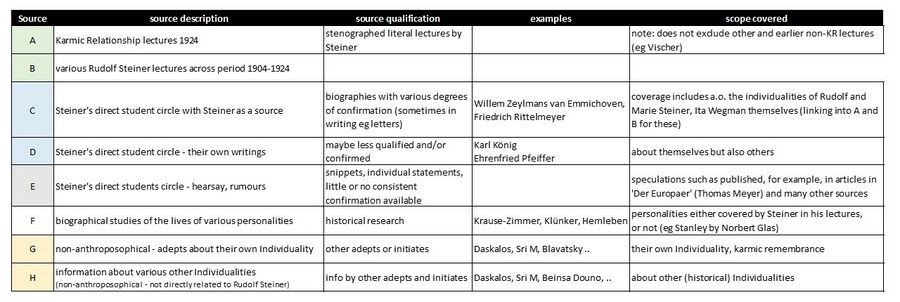

![depicts a simple metaphoric image for the main karmic patterns, challenges and debts in one's life or incarnation. On the upper left is represented the accounting 'balance sheet' of karmic unbalances as a result of many previous lives, the 'book of lives' (part of Man's higher spiritual self or Individuality), also called 'causal body' in theosophy. In the accounting metaphor, each life delivers like the equivalent of 'annual results' that is added to the balance sheet in the process and journey between death and a new birth. Quote: "don’t think that karma plays out in such a way that we would be able to immediately pay off all the debts we have incurred in a previous incarnation, in the next one. It is not that simple. Sometimes one will have to go through many, many incarnations.If you would be able to look back for a moment and see everything, all the marks in your astral body that need to be redeemed, prior to your rising to a certain degree of spiritual maturity, you would see your whole debt account." (1907-11-07-GA098) The karmic ledger image also is used in this quote pointing out it is not always about the past but also about the future: "It is so easy to grasp everything that fits into the chain of our karma as a karmic debt ... [but] that is by no means always the case. As true as karma is a true, all-encompassing law, it is equally true that karmic events can be the very first to enter our causal context. The events that befall us are not always compensations for the past; often they are the first entries in our life's account, which will only find their corresponding balance in the future. Just as a merchant has to record entries for the first time on one side, so it is with the entries in our karmic ledger." (1905-07-23-GA264) When we investigate our current life with biography work and karma exercises (on the right), we will find particularities, obvious or recurrent challenges, curious patterns. Some don't seem to belong in our experience of this current life, and/or may be an odd aspect of our Personality, even though we feel and have to acknowledge they are an intrinsic part of our true self (and Individuality). Depending on the individual, the process may include spontaneous Past life memories, whereby certain karmic patterns may clearly point to a particular previous incarnation. Importantly, the patterns are typically interwoven with relationships with key people in our lives (their role, impact, the period of our life) see Karmic relationships. Rudolf Steiner gave examples of the above with the Karma research case studies about the KRI - Karmic Relationships Individualities. During the journey between death and a new birth, before incarnating the soul develops a life plan in the spiritual world, and so each life has a selection of challenges to work and balance out these karmic unbalances - see a.o. Schema FMC00.287. The image of the slide projector depicts how patterns seen in one life stem from elements from various previous lives shown here as overlay slides. Initiation is the process of fast tracking this process (versus the 'wheel of karma') by taking on this work on our human character consciously during incarnate life with daily initiation exercises.](/w/images/thumb/b/b6/FMC00.531.jpg/1100px-FMC00.531.jpg)
